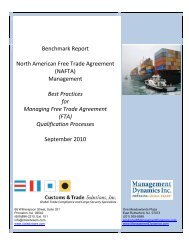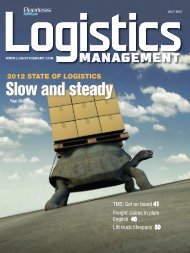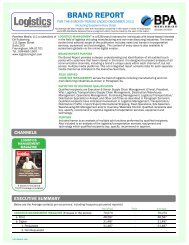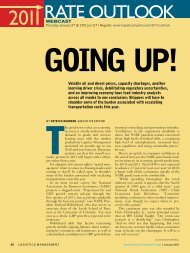Logistics Management - June 2010
Logistics Management - June 2010
Logistics Management - June 2010
You also want an ePaper? Increase the reach of your titles
YUMPU automatically turns print PDFs into web optimized ePapers that Google loves.
Special Report: Top 50 Global 3PLs<br />
A SPECIAL SUPPLEMENT TO LOGISTICS MANAGEMENT<br />
be shortened if the currency imbalance<br />
continues to be an issue with China.<br />
Near-shoring, he says, makes a lot more<br />
sense if long-term and sustainable profits<br />
can be realized.<br />
“It’s going to be very interesting to<br />
see if 3PLs will begin to concentrate<br />
on businesses with production facilities<br />
in North America,” says Armstrong.<br />
“From a foreign currency exchange<br />
perspective, it seems to make sense.”<br />
Meanwhile, change in the 3PL sector<br />
remains glacial, according to Armstrong.<br />
With the exception of DB Schenker,<br />
bold moves into new markets have not<br />
been evident. “Schenker is somewhat<br />
visionary,” says Armstrong, “in that it’s<br />
growing its contract logistics at a very<br />
rapid pace. Shippers should not assume<br />
that this is being done across the board<br />
with 3PLs.”<br />
In fact, the biggest word of advice<br />
Armstrong has for shippers this year is<br />
this: Be reasonable.<br />
“Don’t expect a lot of change in<br />
service levels this year,” he says, “and<br />
don’t rely on new providers coming into<br />
the marketplace. Unless a multinational<br />
manufacturer like Caterpillar comes into<br />
the 3PL sector, it’s going to be the same<br />
group of guys. The threshold for entry<br />
is very high, and requires a big commitment<br />
to operate on a grand scale.”<br />
–Patrick Burnson is Executive Editor of<br />
<strong>Logistics</strong> <strong>Management</strong><br />
The three<br />
dimensions of<br />
distribution<br />
excellence<br />
To achieve the potential of<br />
distribution excellence, companies<br />
need to think outside of the box and<br />
optimize their 3PL partnership.<br />
By Joachim Ebert, Kumar Venkataraman, Michael Hu<br />
What allows certain companies to deliver<br />
best-in-class distribution performance<br />
while others turn in only average performance<br />
or fail altogether<br />
From our work in this area, we’ve<br />
observed that the leaders in distribution—those that<br />
deliver on a defined set of quality and service levels at<br />
the best possible cost—consistently think outside the<br />
box. They push their competitiveness to an efficiency<br />
frontier, achieving a 15 percent to 30 percent distribution<br />
cost advantage over competitors while delivering<br />
equal or better service levels.<br />
Some of these leaders go a step further and leverage<br />
successes in distribution optimization as a catalyst<br />
to improve performance across the entire value<br />
chain—from demand planning to logistics—both to<br />
improve the top-line and unlock additional savings.<br />
We characterize the approach as “3D” outside-thebox<br />
thinking because it requires the following three<br />
dimensions: Benchmarking beyond industry boundaries,<br />
challenging preconceived views, and triggering a<br />
chain reaction in supply chain optimization.<br />
54S <strong>June</strong> <strong>2010</strong> • <strong>Logistics</strong> <strong>Management</strong>

















